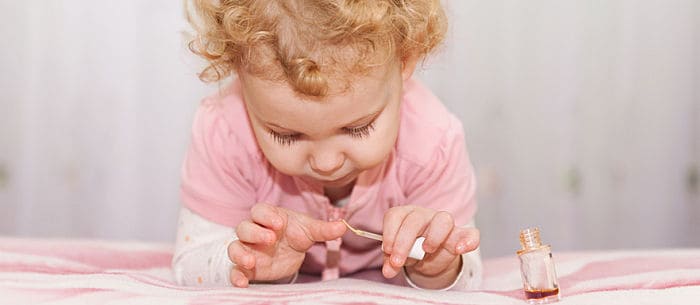Itty bitty fingernails and toenails painted with baby nail polish looks adorable, and those bright colors can even come in handy. Some moms of twins use nail polish as a way to help others differentiate which twin is which. But is it safe to paint a baby’s nails?
Nail polish hasn’t changed much in the last 100 years when it was created from a recipe for automotive paint, says Rachel Sarnoff, creator of Mommy Greenest. Nail polish contains an array of chemicals, some of which are known to be harmful. However, you don’t have to give up on those tiny pink and purple nails. Nail polish can be safe for children provided you avoid chemicals that pose a danger to small children, notes Kourtney Chase of Kutsie Baby, an online boutique and blog that caters to moms and children.
Five Nail Polish Chemicals to Avoid with Small Children:
- Toluene
Added to nail polishes to help dissolve other substances, toluene helps stabilize traditional nail polishes. Toluene “may irritate the skin, and inhaling high levels of toluene may be harmful to your nervous system,” Chase says, noting that low levels of toluene exposure can cause headaches and dizziness. It can also be harmful to unborn babies, as it’s been associated with birth defects if a pregnant woman has extended exposure to the toxin.
- Dibutyl Phthalate (DBP)
A clear liquid with a slight odor, DBP is added to nail polish because it helps prevent the polish from becoming brittle. Brittle nail polish doesn’t adhere to nails and lacks the smooth finish most women are looking for. DBP has also been linked to birth defects and is “currently on the California Proposition 65 list of suspected teratogens, which are agents linked to disturbing the development of an embryo,” Chase notes. “DBP is banned in Europe because of links to reproductive issues,” adds Sarnoff. The chemical might also increase the risk of certain types of cancer. High levels of exposure can lead to liver and kidney failure. DBP is banned in children’s toys and other items that go in a child’s mouth, but since nail polish isn’t generally viewed as something for babies, the chemical is something you should keep in mind when thinking about painting your baby’s nails.
- Formaldehyde
Used as a preservative for cadavers, formaldehyde is also a common ingredient in nail polishes. The ingredient is used to help nail polish harden so that it dries properly. However, formaldehyde is a known human carcinogen. That means it’s linked to cancer, says Chase. The chemical is also an irritant to the eyes and respiratory tract. In addition to inhaling the chemical during the nail-painting process, your baby will also be exposed to formaldehyde the entire time that the polish is on her nails.
- Formaldehyde Resin
Similar to formaldehyde, formaldehyde resin helps nail polishes harden as they dry. The chemical is also an allergen and known carcinogen.
- Camphor
This chemical is added to nail polish to help prevent it from chipping. At the very least, camphor can cause yellowing of the nails, but in large doses or high levels of exposure, it can lead to seizures and disorientation.
“It’s no surprise that when a child sees her mommy doing her nails, she immediately wants to participate!” Chase notes. If you want to give your baby or toddler a manicure or pedicure, look for baby nail polish labeled “5-free,” which means it doesn’t contain any of those five potentially dangerous chemicals. Also, choose “water-based polishes to avoid toxic chemicals,” Sarnoff recommends. Chase’s choice is the Ella+Mila brand, which is “5-free.” Piggy Polish and Hopscotch Kids are additional 5-free brands to look for. As always, consult your pediatrician if you have any questions regarding the health and safety of your baby.
Sara Ipatenco is an elementary school teacher turned stay-at-home mom and freelance writer. Ipatenco holds a bachelor’s degree and master’s degree, both in child development and elementary education. Ipatenco has been published in “Teaching Tolerance” and “Family Fun” magazines.






